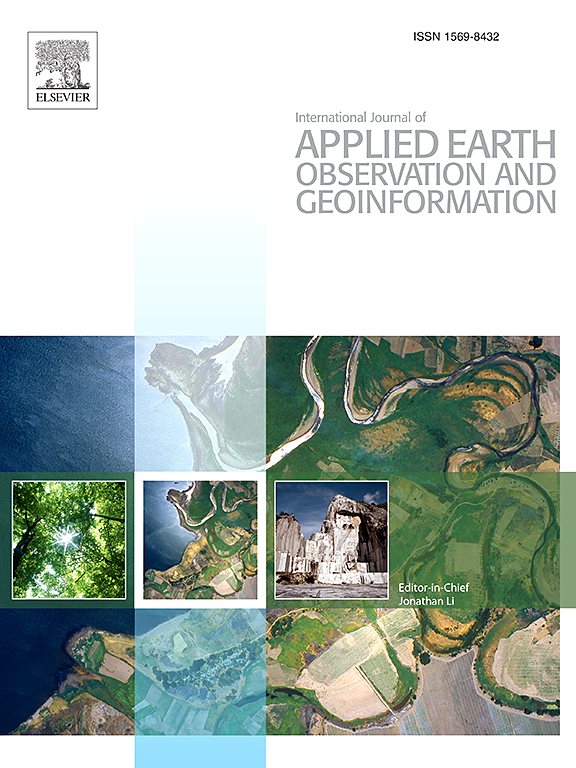用于高光谱图像分类的伪类分布引导的多视角无监督域自适应
IF 7.5
1区 地球科学
Q1 Earth and Planetary Sciences
International Journal of Applied Earth Observation and Geoinformation
Pub Date : 2025-01-15
DOI:10.1016/j.jag.2025.104356
引用次数: 0
摘要
无监督域自适应(UDA)在跨场景高光谱图像分类中取得了很大进展。现有的方法主要集中在对齐源域和目标域的分布。然而,它们都忽略了TD数据隐含的类分布信息,这有助于模型以更高的后验概率预测类。为了解决上述问题,我们提出了伪类分布引导的多视图无监督域自适应高光谱图像分类方法(PCDM-UDA)。我们将标签校正转化为一个0 - 1规划问题,并以估计的伪类分布作为约束对其进行优化。利用校正后的标签对网络进行微调,将班级分布信息整合到网络中。引入频域相位图作为提取域稳定特征的附加分支。为了可靠地融合两个分支的预测信息,我们在方法中引入了主观逻辑和Dempster规则。此外,我们设计了一个自适应风格的学习模块,以增强模型的类间可分性。在三个公共数据集上的大量实验结果表明,所提出的方法优于最先进的方法。源代码可从https://github.com/jixiangyu0501/PCDM-UDA获得。本文章由计算机程序翻译,如有差异,请以英文原文为准。
Pseudo-class distribution guided multi-view unsupervised domain adaptation for hyperspectral image classification
Unsupervised domain adaptation (UDA) has made great progress in cross-scene hyperspectral image (HSI) classification. Existing methods focus on aligning the distribution of source domain (SD) and target domain (TD). However, they all ignore the implicit class distribution information of TD data, which can help the model predict the class with a higher posterior probability. To solve the above issue, we propose pseudo-class distribution guided multi-view unsupervised domain adaptation for hyperspectral image classification (PCDM-UDA). We transform the label correction into a zero–one programming problem and optimize it with the estimated pseudo-class distribution as a constraint. The corrected labels are used to fine-tune the network, which can integrate class distribution information into the network. The frequency domain phase view is introduced as an additional branch to extract domain stable feature. To credibly fuse the information from the prediction of the two branches, we introduce the Subjective logic and Dempster’s rule into our method. In addition, we design an adaptive style learning module to enhance the inter-class separability of the model. Extensive experimental results on three public datasets demonstrate that the proposed method outperforms the state-of-the-art methods. The source code is available at https://github.com/jixiangyu0501/PCDM-UDA .
求助全文
通过发布文献求助,成功后即可免费获取论文全文。
去求助
来源期刊
CiteScore
10.20
自引率
8.00%
发文量
49
审稿时长
7.2 months
期刊介绍:
The International Journal of Applied Earth Observation and Geoinformation publishes original papers that utilize earth observation data for natural resource and environmental inventory and management. These data primarily originate from remote sensing platforms, including satellites and aircraft, supplemented by surface and subsurface measurements. Addressing natural resources such as forests, agricultural land, soils, and water, as well as environmental concerns like biodiversity, land degradation, and hazards, the journal explores conceptual and data-driven approaches. It covers geoinformation themes like capturing, databasing, visualization, interpretation, data quality, and spatial uncertainty.

 求助内容:
求助内容: 应助结果提醒方式:
应助结果提醒方式:


